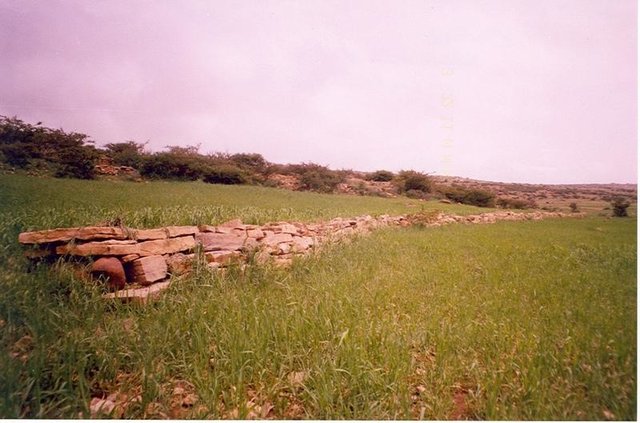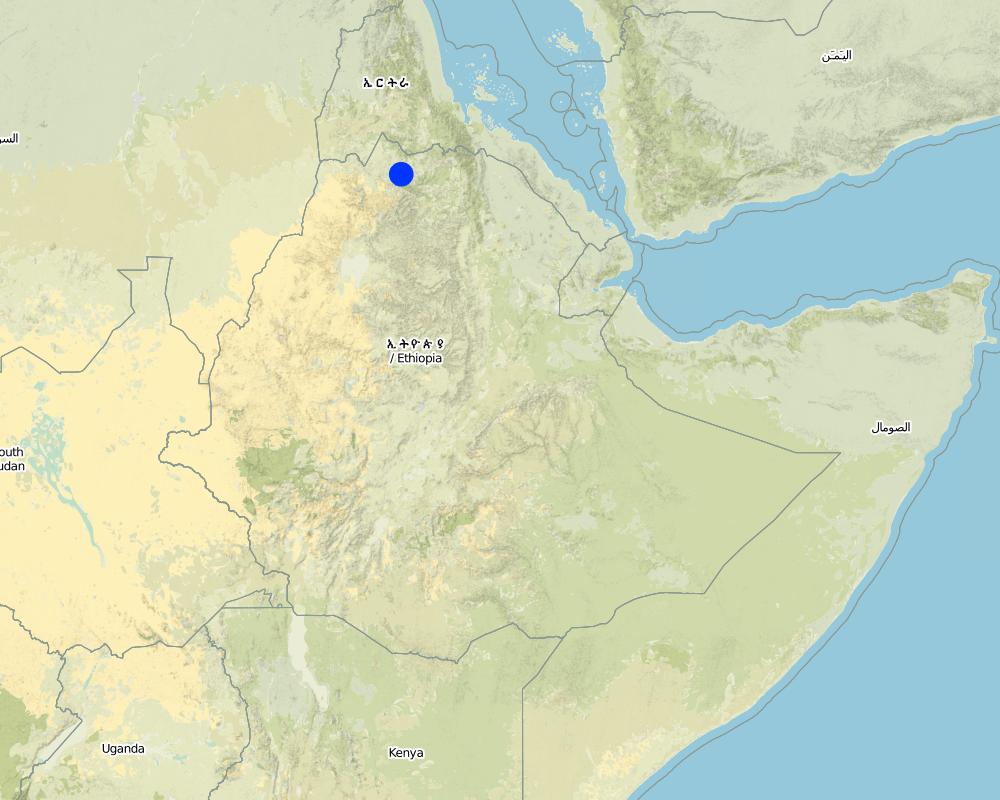Mass mobilization [Ethiopia]
- Creation:
- Update:
- Compiler: Unknown User
- Editor: –
- Reviewer: Fabian Ottiger
approaches_2376 - Ethiopia
View sections
Expand all Collapse all1. General information
1.2 Contact details of resource persons and institutions involved in the assessment and documentation of the Approach
Key resource person(s)
SLM specialist:
Wolde Gabriel
Tigray Bureau of Agriculture
Mekele
Ethiopia
1.3 Conditions regarding the use of data documented through WOCAT
The compiler and key resource person(s) accept the conditions regarding the use of data documented through WOCAT:
Yes
1.4 Reference(s) to Questionnaire(s) on SLM Technologies

Stone bund of Tigray [Ethiopia]
an allignment of stone along the contour line which stabilzes with grass species
- Compiler: Unknown User
2. Description of the SLM Approach
2.1 Short description of the Approach
Mass Mobilization is an approach pursued to implement SLM technologies by organizing land users to undertake SLM activities without incentives being involved.
2.2 Detailed description of the Approach
Detailed description of the Approach:
Aims / objectives: It involves the process of mobilizing and organizing land users in the community (men, women, and youth) who are able-bodied to participate in SLM activities. Land users participating in mass mobilization are required to form SLM groups. Plan for SLM is made at the woreda level and then distributed to kebeles and or sometimes each kebele proposes plan, which is later approved by the woreda. Each member contributes free labor of 20 days every year to undertake land management technologies (past) and this contribution is increased to account for 40 days a year since 2009. The specific objective is to make land users participate in the management of land by implementing improved technologies. SLM measures control runoff and enhance rainfall water percolation. The approach involves organizing land users in SLM groups. Recently two groups are formed known as development team and a sub group called a work team. A development team group comprises 20-30 members while the work team group is 10-15 members. Women and men participate equally in the work groups and in leading the team. Activities undertaken by mass mobilization are mostly (80%) carried out on cultivated lands. Every day the group evaluates its activities. They also participate on the discussions of the plan.
Methods: There is a leader for each group and a production cadre for the groups at Kushet level (the lower administrative unit) who supervises activities of the groups. The groups also work on activities other than SLM. Problems addressed include: soil erosion, deforestation, declining productivity of land, low fertility of soil, low level of participation of the community in SLM activities. All land users in the community are expected to participate in the implementation of the technologies through the mass mobilization approach. The approach area is defined by administrative and as well as watershed boundaries. The Kebele and woreda administrators, woreda specialists and development agents coordinate the implementation and planning of the approach.
2.5 Country/ region/ locations where the Approach has been applied
Country:
Ethiopia
Region/ State/ Province:
Laelay Adet, Tahtay A det, Naedir
Further specification of location:
Tigray, Ethiopia
Map
×2.6 Dates of initiation and termination of the Approach
Indicate year of initiation:
1992
2.7 Type of Approach
- traditional/ indigenous
2.8 Main aims/ objectives of the Approach
The Approach focused mainly on SLM with other activities (Pond & dam construction and other water harvesting technologies.)
Aware, organize and initiate land users to participate in SLM activities that aim at controlling soil erosion, which causes land degradation and encouraging land users to contribute free labor for implementing the SLM technologies introduced. The specific objectives are: I) promote the awareness of land users on land degradation problem and II) show the importance of SLM measures which protect cultivated lands from erosion, retain soil moisture and improve fertility of soils.
The SLM Approach addressed the following problems: Soil erosion, deforestation, low productivity low soil fertility, low participation of community in SWC activities.
2.9 Conditions enabling or hindering implementation of the Technology/ Technologies applied under the Approach
social/ cultural/ religious norms and values
- hindering
Many holidays are celebrated, and land users do not work on those days.
Treatment through the SLM Approach: Create awareness to work on those days.
availability/ access to financial resources and services
- hindering
Low income of the community
Treatment through the SLM Approach: Create other off farm activities
legal framework (land tenure, land and water use rights)
- enabling
The existing land ownership, land use rights / water rights moderately helped the approach implementation: There is use right of land users.
knowledge about SLM, access to technical support
- hindering
Widely spaced bunds do not control inter bund erosion.
Treatment through the SLM Approach: Training to be provided and also promote awareness.
3. Participation and roles of stakeholders involved
3.1 Stakeholders involved in the Approach and their roles
- local land users/ local communities
Tabias
Working land users were work equally divided between men and women. All community member participate equally in decision making.
- national government (planners, decision-makers)
BOA & Regional Adminstration
- international organization
3.2 Involvement of local land users/ local communities in the different phases of the Approach
| Involvement of local land users/ local communities | Specify who was involved and describe activities | |
|---|---|---|
| initiation/ motivation | passive | public meetings: general assembly meeting called for awareness creation and informing about the development plan. |
| planning | passive | Training: train SLM commission members. They plan the activities which is later endorsed by the general assembly. |
| implementation | interactive | Free labour: 20 days per year |
| monitoring/ evaluation | passive | Measurements observation reporting: each activity is measured by the team leader and the other committee members. |
| Research | none |
3.4 Decision-making on the selection of SLM Technology/ Technologies
Specify who decided on the selection of the Technology/ Technologies to be implemented:
- mainly SLM specialists, following consultation with land users
Explain:
Decisions on the method of implementing the SLM Technology were made by mainly by SLM specialists with consultation of land users
4. Technical support, capacity building, and knowledge management
4.1 Capacity building/ training
Was training provided to land users/ other stakeholders?
Yes
Specify who was trained:
- land users
- SWC specialists, extensionists/trainers (1), politicians/decision makers (2)
Form of training:
- on-the-job
- farmer-to-farmer
- demonstration areas
- courses
Subjects covered:
On desing, layout & construction methods of SWC technologies, moisture harvesting techniques.
4.2 Advisory service
Do land users have access to an advisory service?
Yes
Specify whether advisory service is provided:
- on land users' fields
Describe/ comments:
Name of method used for advisory service: House hold pack (PADET); Key elements: DA, Contact farmer; 1) Advisory service was carried out through: government's existing extension system; Extension staff: mainly government employees 2) Target groups for extension: land users, technicians/SWC specialists; Activities: Contrubuting free labour; Training, supervising, monitoring & evaluation, creating awarness in the co
Advisory service is quite adequate to ensure the continuation of land conservation activities
4.3 Institution strengthening (organizational development)
Have institutions been established or strengthened through the Approach?
- yes, moderately
Specify the level(s) at which institutions have been strengthened or established:
- local
Specify type of support:
- capacity building/ training
- equipment
4.4 Monitoring and evaluation
Is monitoring and evaluation part of the Approach?
Yes
Comments:
bio-physical aspects were ad hoc monitored through measurements; indicators: soil depth, change in land use and land cover
technical aspects were regular monitored through measurements; indicators: dimensions and quality
economic / production aspects were ad hoc monitored through measurements; indicators: increase in production per unit area
area treated aspects were regular monitored through measurements; indicators: extent of work done
no. of land users involved aspects were regular monitored through measurements; indicators: number of participating land users in the work
management of Approach aspects were regular monitored through observations; indicators: impacts and changes
There were few changes in the Approach as a result of monitoring and evaluation: At initial stage of the implementation of the approach the cummunity members were contributing their free labour 3 month per year for SWC activities, but through evaluation it has been changed to 20 days/year.
5. Financing and external material support
5.1 Annual budget for the SLM component of the Approach
If precise annual budget is not known, indicate range:
- 2,000-10,000
Comments (e.g. main sources of funding/ major donors):
Approach costs were met by the following donors: government (Training and work tools support): 5.0%; local community / land user(s) (Labor and material): 95.0%
5.2 Financial/ material support provided to land users
Did land users receive financial/ material support for implementing the Technology/ Technologies?
Yes
5.3 Subsidies for specific inputs (including labour)
- equipment
| Specify which inputs were subsidised | To which extent | Specify subsidies |
|---|---|---|
| tools | partly financed | |
- agricultural
| Specify which inputs were subsidised | To which extent | Specify subsidies |
|---|---|---|
| seeds | partly financed | |
- infrastructure
| Specify which inputs were subsidised | To which extent | Specify subsidies |
|---|---|---|
| Community infrastructure | fully financed | |
If labour by land users was a substantial input, was it:
- voluntary
5.4 Credit
Was credit provided under the Approach for SLM activities?
No
6. Impact analysis and concluding statements
6.1 Impacts of the Approach
Did the Approach help land users to implement and maintain SLM Technologies?
- No
- Yes, little
- Yes, moderately
- Yes, greatly
To conserve their individual land by them selves.
Did other land users / projects adopt the Approach?
- No
- Yes, little
- Yes, moderately
- Yes, greatly
In some jfood for jwork & chas for work SWC activities they apply this approach to contribute some perventage of the activities as a free labour.
6.3 Sustainability of Approach activities
Can the land users sustain what has been implemented through the Approach (without external support)?
- yes
6.4 Strengths/ advantages of the Approach
| Strengths/ advantages/ opportunities in the compiler’s or other key resource person’s view |
|---|
| Wokring in group improves the management of large area of cultivated lands in short period (How to sustain/ enhance this strength: More training, awareness and study tour opportunities to be provided. Provision of hand tools.) |
| Easy transfer of technology possible |
6.5 Weaknesses/ disadvantages of the Approach and ways of overcoming them
| Weaknesses/ disadvantages/ risks in the compiler’s or other key resource person’s view | How can they be overcome? |
|---|---|
| Unwillingness from some land users to work in groups | Convincing land users. |
7. References and links
7.1 Methods/ sources of information
- field visits, field surveys
- interviews with land users
Links and modules
Expand all Collapse allLinks

Stone bund of Tigray [Ethiopia]
an allignment of stone along the contour line which stabilzes with grass species
- Compiler: Unknown User
Modules
No modules


